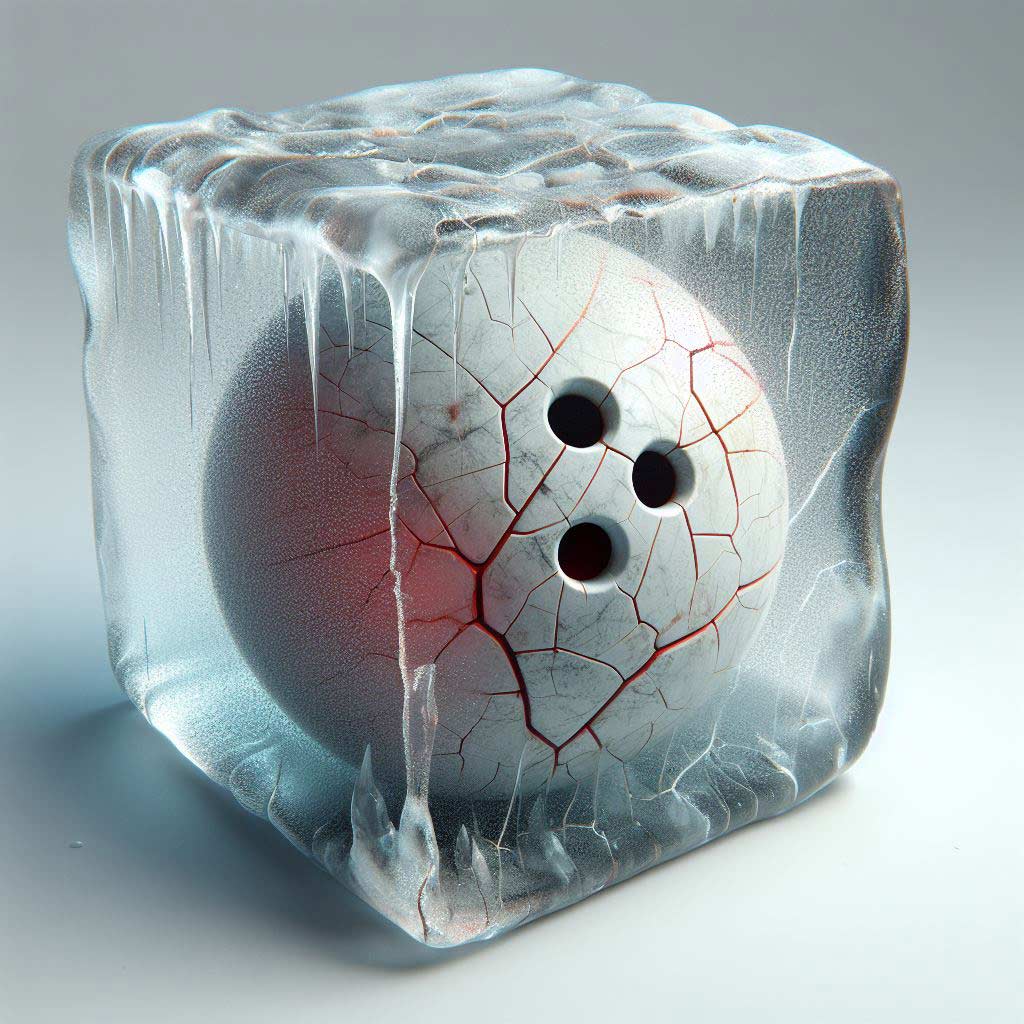As any dedicated bowler knows, a high-quality bowling ball is a significant investment. Between the cost of the ball itself and the time and effort put into selecting the perfect fit and drilling the holes, you want to do everything you can to protect your equipment.
One common concern many bowlers have is whether extreme cold weather can cause their bowling balls to crack or become damaged. After all, cold temperatures can wreak havoc on all sorts of materials, so it’s natural to worry about the impact on something as dense and important as a bowling ball.
In this comprehensive guide, we’ll explore the science behind what causes bowling balls to crack, whether the cold is a real threat, and most importantly, provide practical tips to help you prevent cold-related damage to your prized possession.
What Causes Bowling Balls to Crack?
To understand if cold weather is a true threat, it’s helpful to first look at the general factors that can lead to cracks and damage in bowling balls.
At their core, bowling balls are remarkably sturdy and durable. They are typically made from a combination of materials, most commonly resin, polyester, or urethane. These materials are chosen for their ability to withstand the intense impact and friction forces involved in the sport of bowling.
However, bowling balls are not indestructible. Over time and with heavy use, the core and cover of a ball can start to break down, leading to cracks, chips, or other structural damage. Some of the most common culprits include:
- Physical Impacts and Drops – Perhaps the most obvious cause of bowling ball damage is physical impact. Dropping a ball, even from a relatively short height, can create cracks or chips in the surface. Repeatedly slamming a ball down on the floor of the bowling alley can also take a toll.
- Improper Drilling and Fitting – Getting a ball drilled and fitted properly is essential. If the holes are not the right size or placement for your hand, it can create stress points that eventually lead to cracking. Poorly executed drilling can compromise the ball’s structural integrity.
- Lack of Maintenance – Proper cleaning, polishing, and maintenance of a bowling ball’s surface is crucial. Over time, the outer layer can become worn, dried out, or damaged if not properly cared for. This leaves the ball more vulnerable to cracking.
- Exposure to Extreme Temperatures – Sudden and dramatic changes in temperature, whether hot or cold, can also cause damage to bowling ball materials. Extreme heat can cause the ball to expand and warp, while extreme cold can make the materials more brittle and prone to cracking.
So in summary, while bowling balls are built to withstand a lot of punishment, they are not invincible. A combination of physical forces, improper care, and exposure to environmental conditions can all contribute to the development of cracks, chips, or other structural issues over time.
Do Bowling Balls Crack in the Cold?
Now that we understand some of the general factors that can lead to bowling ball damage, let’s dive deeper into the specific issue of cold weather and how it may impact these durable sports balls.
The short answer is yes, bowling balls can crack or become damaged in cold temperatures. There is scientific evidence to support this, as well as many real-world accounts from bowlers who have experienced this problem.
The primary reason cold weather is a threat has to do with the materials used in bowling ball construction. As mentioned earlier, the two most common materials are resin and urethane. Both of these can become more brittle and prone to cracking when exposed to extreme cold.
When the temperature drops, the molecular structure of these materials starts to change. The polymers and other compounds that make up the ball’s core and cover become less flexible and more rigid. This increased brittleness makes the ball more susceptible to cracking or shattering upon impact.
A 2015 study published in the Journal of Sports Engineering and Technology looked specifically at the effects of temperature on bowling ball performance. The researchers tested balls at a range of temperatures, from 40°F up to 100°F. They found that balls tested at the lower end of that range (40-50°F) exhibited significantly more cracks, chips, and other signs of structural damage compared to those tested at warmer temperatures.
The study concluded that “temperature has a significant effect on the mechanical properties of bowling balls,” and that cold conditions in particular can “increase the risk of ball damage during play.”
Beyond the scientific research, there are countless real-world accounts from bowlers who have experienced cracked or damaged balls due to cold weather. Many have shared their stories on bowling forums and social media, with reports of balls cracking during tournaments played in cold arenas or while being transported in the wintertime.
One bowler on the Reddit r/Bowling subreddit shared their experience:
“I left my ball in my car overnight when it was around 20°F outside. The next day when I got to the alley, there was a huge crack all the way around the ball. Completely ruined it. I learned my lesson – never leave your equipment out in extreme cold!”
Another bowler on a Facebook bowling group lamented:
“I was bowling in a tournament last month and it was freezing cold in the bowling center. My ball developed a nasty crack after just a few frames. Couldn’t even finish the tournament. Very frustrating to have that happen to a fairly new ball.”
So in summary, the evidence is clear – bowling balls are indeed susceptible to cracking and other cold-related damage, especially when exposed to extended periods of extreme low temperatures. Bowlers need to be proactive in protecting their equipment to avoid this costly and frustrating issue.
Tips to Prevent Cold-Related Cracking
Now that we understand the science behind why cold weather can damage bowling balls, the next crucial step is learning how to prevent it. Fortunately, there are several effective strategies bowlers can employ to keep their equipment safe, even in the coldest conditions.
Here are the top tips for protecting your bowling balls from the ravages of winter:
Proper Storage and Transportation
One of the most important things you can do is ensure your bowling balls are properly stored and transported when the mercury drops. Avoid leaving your balls in a cold car, unheated garage, or any other environment where they will be subjected to freezing temperatures for extended periods.
Instead, invest in a high-quality roller bag or bowling ball case designed for transporting balls in cold weather. Look for insulated models that will help maintain a stable, moderate temperature even in frigid conditions. When possible, bring your balls into a warm indoor environment rather than leaving them in your vehicle.
Use Ball Warmers
Another highly effective preventative measure is to utilize ball warming devices. These specialized products are made to gradually heat up your bowling balls to the optimal temperature range before use.
Ball warmers come in a variety of styles, from small, portable units you can keep in your bowling bag, to larger, multi-ball warming cabinets designed for shop or pro shop use. Placing your balls in a warmer for 30-60 minutes before hitting the lanes can make a big difference in protecting them from cracking in the cold.
Just be sure to follow the manufacturer’s instructions carefully and never try to rapidly heat a cold ball, as that can also cause damage.
Acclimate Balls Slowly
If you do need to move a cold bowling ball from one environment to another, it’s crucial to let it acclimate slowly rather than exposing it to an abrupt temperature change. For example, if you’re bringing a ball from your freezing car into a warm bowling alley, set it aside for 30-60 minutes to gradually adjust to the new conditions.
Rushing the acclimation process can cause the materials to expand or contract too quickly, leading to cracks, chips, or other structural issues. Take the time to let the ball warm up gradually to minimize the risk of cold-related damage.
Inspect Balls Regularly
Vigilant inspection of your bowling equipment is always important, but it’s especially crucial during the colder months. Make it a habit to thoroughly examine your balls for any signs of cracking, chipping, or other structural problems before and after each use.
Pay close attention to the surface, drilling, and core of the ball. Even small hairline cracks can quickly worsen in cold conditions, so catching issues early is key. If you do notice any damage, address it right away by taking the ball to a professional pro shop for evaluation and potential repair.
Invest in Quality Equipment
While it may be tempting to try to save money by purchasing cheaper, lower-quality bowling balls, this can actually backfire when it comes to cold weather durability. Balls made with premium materials like high-performance resins and urethane covers tend to be far more resistant to cracking in extreme temperatures.
When shopping for new equipment, do your research and look for balls specifically designed to withstand the rigors of cold environments. Many manufacturers now offer “cold-resistant” models optimized for winter play. Spending a little extra upfront can save you a lot of headaches (and money) down the road.
By implementing these best practices for cold weather bowling ball care, you can help ensure your investment remains in top condition no matter how low the mercury drops. With a little extra diligence, you can overcome the challenges posed by Old Man Winter and keep your game at its best all year round.
Conclusion
Bowling balls may be tough, but they are not impervious to the damaging effects of extreme cold weather. As we’ve explored in this comprehensive guide, sudden temperature drops can cause these dense sports balls to become increasingly brittle and prone to cracking or other structural issues.
The science is clear – the materials used in bowling ball construction, namely resin and urethane, undergo significant changes in their molecular structure when exposed to frigid conditions. This increased brittleness makes the balls much more vulnerable to damage from impacts and other forces.
In the real world, countless bowlers have shared their stories of ruined equipment due to cold weather, from balls cracking during tournaments held in chilly arenas to equipment left overnight in freezing cars. The evidence is abundant that this is a very real and potentially costly problem for any serious bowler.
Fortunately, there are several proactive steps you can take to protect your bowling balls from the ravages of winter. Proper storage, the use of ball warmers, slow acclimation to temperature changes, regular inspections, and investing in high-quality cold-resistant equipment are all effective strategies.
By implementing these best practices, you can help ensure your bowling balls remain in peak condition no matter how low the mercury drops. With a little extra care and attention, you can overcome the challenges posed by Old Man Winter and keep your game at its best all year round.
So the next time you find yourself lacing up your shoes on a blustery winter day, remember the importance of prioritizing the safety and longevity of your most crucial piece of equipment – your bowling ball. A little prevention today can save you a lot of heartache (and expense) down the lane.





